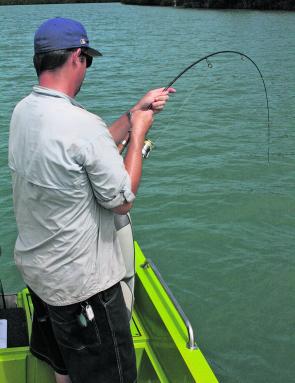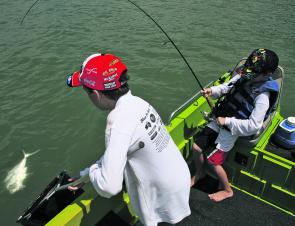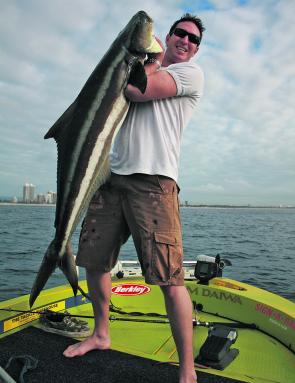I have a complaint to make about modern fishing tackle. There is no doubt that a new spin reel that has multiple drag washers attached to a high modulus graphite rod and packed with fine braided line is an awesome piece of kit, and I’m proud to say that I have a number of them in my collection, but it has created one small issue. Most of us have forgotten how to play a big fish on fragile tackle.
I learnt how to fish by catching mulloway on side-cast tackle. The rods we were using couldn’t even pass as tomato stakes these days, and the fishing line we had to choose from is now being sold as whipper snipper cord. There was no way that you could go too heavy on the line, otherwise the old fibreglass rod was not going to cast that bait anywhere near where you wanted to be. Soapies (small mulloway) I could handle, and school size mulloway were also no big deal. However, after losing a few monsters I soon learnt how to bring a fish into the boat or beach with as little fuss as possible.
My old Alvey had no drag system and the 12’ glass rod had no ‘feel’ in it at all compared to today’s works of art. It really was angler vs fish back then.
By the time I joined a fishing club, I was learning how to catch big fish on pre-test monofilament line. For those who don’t know, the only difference between pre-test line and standard monofilament is that the pre-test stuff is guaranteed to break at, or just below, its rated strength. That’s in complete contrast to today’s modern lines which are often twice as strong as their rating. It wasn’t long before I was chasing mangrove jack and kingfish on 2kg pre-test in order to win points for club competitions. Drag washers were now some of my most serviced pieces of equipment and I spent hours rubbing my washers on very fine wet and dry sandpaper laid over a small sheet of glass. The smoother these washers were, the more fish I landed.
It was back then that I attended a talk by Peter Pakula, who was ‘the man’ when it came to game fishing. I was expecting Peter to talk about his range of lures and how to troll or rig them for best results but he actually spent a lot of time talking about how to play a fish in so that it could be released to live another day. The best way to bring a fish to the boat was not to exhaust it completely so you could just drag its dead weight to the tag pole or gaff, but to be smart and use angles as well as the boat to land your catch. It was all about how to angle fish in and becoming a master angler instead of a casual dangler.
A fish that has been fought to the point of complete exhaustion has a very small chance of survival, so if we intend to release these fish it’s vital that we take care of them.
Having said that, there is a problem with bringing big fish into a boat when they are still full of energy or ‘green’. I’m not just talking about fish with bills or sharp teeth, either. Any fish that’s franticly jumping all over a hard and often hot deck of a boat is going to do itself more harm than we would have done by keeping it in the water until it started to fatigue. There’s a big difference between fatigue and exhaustion.
I’m not much of a game fisherman – I prefer the calmer water – but the principles are the same. And let’s face it, we need to know what to do when that metre long barra or monster mulloway decides to eat what is attached to our light tackle. I still chase wild river barra on bream spinning gear, not so much for the challenge but when these fish are shut down nothing will get them to eat except a tiny prawn which requires light tackle to work it.
When I talk about working the angles I try never to play a fish from directly under the boat. I want a fish to be either pulling line from the drag or be coming to the surface from at least a 45º angle. The reason for this is simply pressure. The weight of the fish when it is under the boat means that we have to pull that weight up through the water, and if the fish weighs 20kg and my line breaks at 4kg, this is going to put a lot a pressure on that line. I may not have the entire weight of the fish on the line but if it decides it doesn’t like the look of the boat as it gets closer to the surface, the fish can very easily dive deeper, expending very little energy in doing so – and I am back where I started.
Playing the angles means that the fish needs to swim against my drag pressure and also, as soon as it stops to rest, I am gaining line on it without having to lift it vertically through the water. It also forces the fish towards the surface, which in a lot of cases is where we want it to be.
A word a caution here: know your prey well. For example, a barramundi coming to the surface will want to jump which can throw the hooks. If a big flathead breaks the surface, it starts throwing its head from side to side which runs those big buck teeth over the leader, and that can also end in tears. So while you want to get the fish up and away from the boat, try to keep it under the surface if possible.
When fishing for mackerel from anchor, I use a buoy that is attached to the anchor rope via a large stainless steel clip. If I hook a good fish, I unclip the rope from the buoy and move around with no rope for the fish to run under. Additionally, I have a bow-mounted electric motor (all my boats have had one) so if it’s not too rough I can steer the boat around, keeping the fish away from the boat in order to have that angle.
Living in Weipa for a few years meant having to beat the sharks to any mackerel that I hooked so I became good at landing mackerel in record time. The added benefit of the floating buoy was that once I landed the fish I just clipped back onto the buoy and I was anchored back on my mark.
The game fishermen from my fishing club did a similar thing on big marlin by driving away from the fish to bring it up, then backing into it as the angler started to gain line. As soon as the fish went deep, it was time to drive away again, forcing it back towards to surface where the backing up process would begin again. Being on board when a big marlin is hooked is an experience. Everyone is involved in landing that fish, especially the skipper.
Inshore fishing is a little different because we can’t always let the fish run. Mangrove jack, barramundi and even bream will head back into cover and at times it’s a case of pulling them up or being cut off on the structure. A few years back I found a set of oyster leases that had a lot of big mangrove jack living amongst the structure and it was more of a case of learning how to rig up and tie knots than learning how to play them in.
Rigging up and setting up the drag are vital if you’re going to land big fish from around structure. Learning to tie doubles and good leader knots are crucial but even terminal tackle can be tested here so do your homework. Bent hooks or that tell-tale ‘pig tail’ on the end of the line indicating that the knot has slipped and let go can be very frustrating.
Drag pressure should never exceed the a third of the actual breaking strain of your line, so if you’re using braid that is rated to 10kg, test it with some quality fish weighing scales to see what it actually breaks at. Attach a good length of it to something solid and, in a smooth and steady motion, pull on the line until it snaps. Yes, you can always just run off the line’s rating as a guide, but when it comes to fighting fish around structure the more pressure you have on the fish before everything gives, the better your chances.
Once you know your breaking strain, set the drag to a third of that number. If my 10kg braid breaks at 15kg, I will set up my drag at 5kg by doing the same things as I did when testing its strength. Attach the scales to the end of the line while in a rod holder and in a very smooth and steady motion, pull back a metre or so to pull drag and check the scales to see what the reading is.
That all sounds simple enough, but if you have never done this before you’re about to find out why game fishing tackle is so expensive! Putting a smooth 5kg of drag into a reel requires some top quality equipment. Big drum-style offshore reels are built for it and when it comes to inshore fishing, baitcasters are usually better than spinning reels for this. However, if it’s a light lure you’re casting or a little soft plastic, this is not always your best option.
Technically speaking, any spin reel in the 2500 size or greater should be able to handle 5kg of drag. However, the cheaper reels with a single washer will fail and become sticky a lot quicker than, say, a Shimano Stella or new Saragosa reel, as well as my favourite old Daiwa Certate which has never let me down. I’m not recommending one brand over another though, because brand choice is less important than just buying the best you can afford. Fellow FM writer Jason Medcalf tells me that he has been using Abu Revo reels which are very well priced and the drags have been holding up to the monster jacks and barra with no problems at all, so there’s another great option. Drag washers can also be upgraded but setting drags is an article in itself, so stick with the best you can afford.
Learning as much as you can about rigging and being able to work the angles will not only put you ahead of the pack with it comes to landing big fish on light tackle, but will give your released fish the best chance of survival.
Reads: 1580
Weipa local Tim Shannon trying to pull up a big fish from straight under the boat and not getting very far. This is the time to move the boat to get an angle on the fish, especially with that light bream gear in the tropics.

A 120cm barra landed from a narrow channel between two weed beds. Knowing your leader and knots are up for the job is half the battle.

Cody Ward doing battle with a queenfish on 8lb braid while big brother Jacob works the net.

Massive cobia are tough no matter what the tackle but this fish was landed during a tailor spinning session on tailor gear.

Big fish, light tackle and kids are a great combination but it still takes work and a little skill to land fish like this on light tackle.




